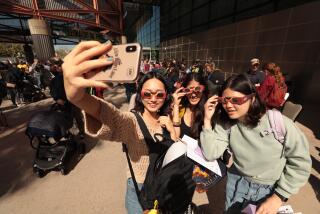Eyeglass Sales Up; User Outlook Changes : Promotion: Advertising is designed to get people to think about owning as many pairs of glasses as they do shoes. The replacement rate has dropped from over two years per pair to 1.8.
WASHINGTON — If boys--or girls--seldom make passes at those who wear glasses, maybe it’s because the glasses aren’t just right for the occasion.
That, anyway, is the line being pushed by eyeglass retailers in recent years, backed by heavy promotions and advertising designed to get people to think about owning as many pairs of glasses as they do shoes.
And according to those who eyeball the $11-billion business, it’s starting to work. A new biannual study, released in late April by the Falls Church, Va.-based Optical Manufacturers Assn., shows that the eyeglass-replacement rate--the closely watched industry measure--has dropped from just over two years per pair to 1.8 years.
“The eyeglass business is doing quite well, mostly because glasses are now an attractive consumer item that people buy on impulse, and the heavy promotions are bringing people to market more frequently,” said Alex Torda, who coordinated the study. “Getting individual customers to buy a new pair of glasses at intervals of less than two years has been a longtime hope for the industry.”
Currently the 60% of the American public that needs glasses buys more than 90 million pairs a year, according to industry figures. A decade ago, it was just over half that number.
Demographic trends explain some of that growth. As the baby boom generation approaches 40, some 90% of them are likely to require some sort of vision aid.
But industry officials say that as important has been the huge range of new materials, colors and designs that has allowed them to transform glasses from merely utilitarian devices to correct vision into bona fide fashion accessories. The new euphemisms for a pair of eyeglasses now range from “eye-wear” to “fashion for the face.”
“They created the demand and now they are serving it,” said Michael Gade, a retail analyst for Coopers & Lybrand in New York. Gade compared the trend to one that occured with watches some years ago. “The ongoing promotions are now catching on,” he said, “and with the affluence of our society it is logical to suggest that people should have a totally different look by changing your glasses.”
With their one-hour service, two-for-one promotions, cut-rate prices, in-house optometrists, big and colorful super-stores, the big chains have been the driving force for the changes in the industry.
The Dallas-based Pearle Vision Centers has led the aggressive charge locally. A subsidiary of Britain’s Grand Metropolitan PLC, which also owns Burger King, Haagen-Dazs and Pillsbury, Pearle had sales of $700 million in 1989 from its 1,300 locations worldwide, up 16% in a year.
It’s also been on an acquisition binge, with purchases this year including the Eyelab chain, whose stores have been converted to Pearle Eyelab Express stores.
Pearle’s ubiquitous advertising mantra--”There’s no excuse for having only one pair of glasses”--started more than a year ago in a multimillion-dollar television and print campaign.
The advertising has been backed by a promotion campaign that offers two pairs of glasses for the price of one, which the company says has increased the number of customers as well as the number of pairs of glasses they buy.
“The economics work for us, raising the number of customer transactions enough to pay for the cost of giving pairs away free,” said Joseph Dono, Pearle’s vice president for marketing.
According to retailers, the average purchase price for a complete pair of glasses is slightly less than $100, though with designer frames and special lenses that cost can escalate quickly. And industry analysts estimate that the retail markup can run as high as 250%.
More to Read
Inside the business of entertainment
The Wide Shot brings you news, analysis and insights on everything from streaming wars to production — and what it all means for the future.
You may occasionally receive promotional content from the Los Angeles Times.










